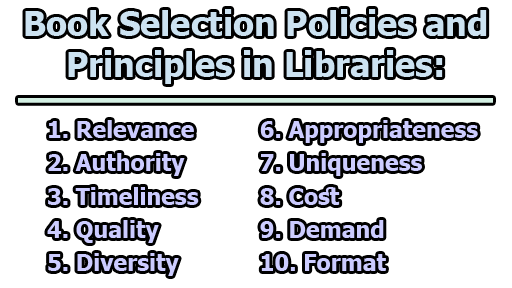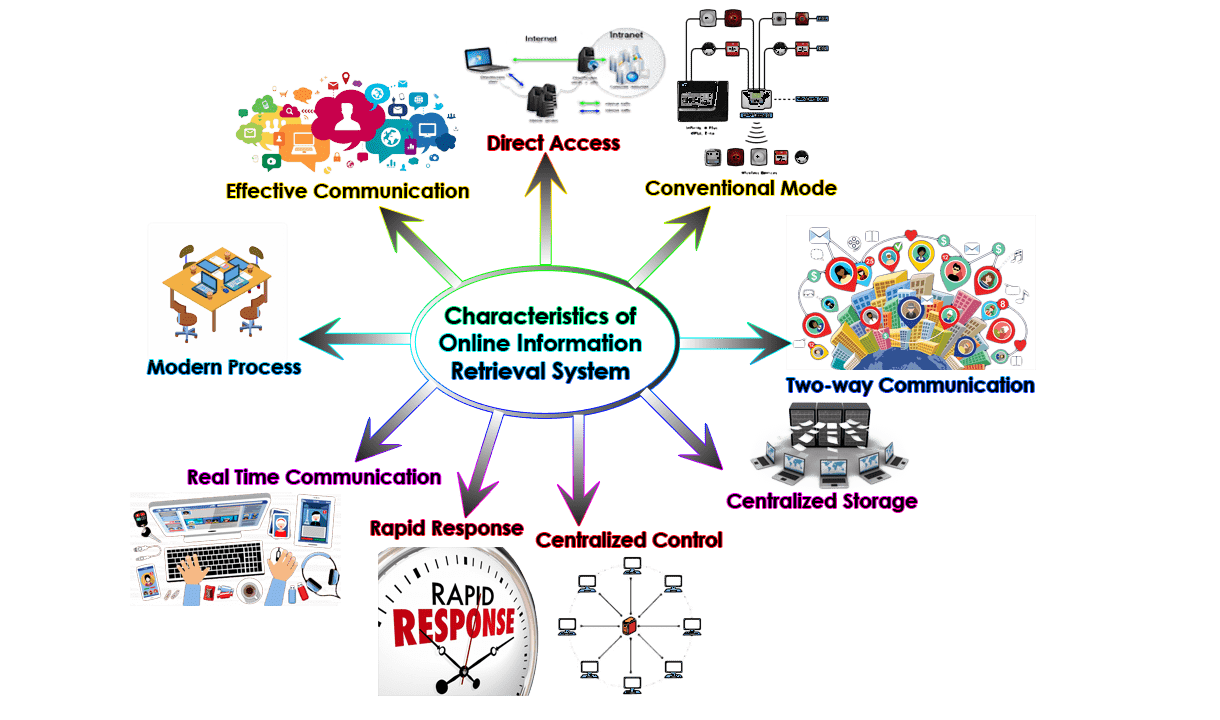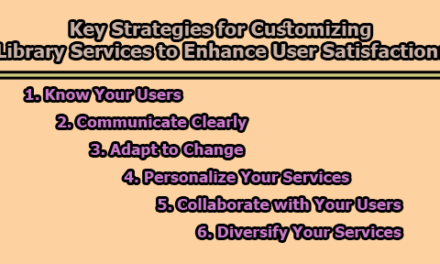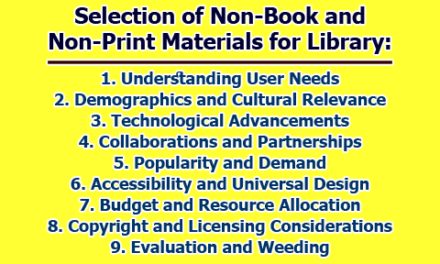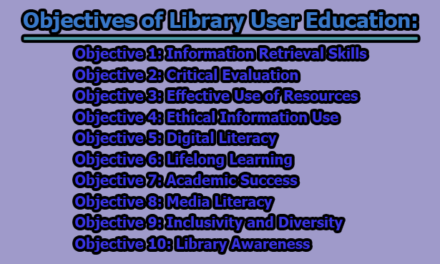Book Selection Policies and Principles in Libraries:
Book selection is a crucial aspect of library management. It involves making decisions about which materials to acquire and add to the library’s collection. These decisions are guided by a set of policies and principles that aim to ensure that the library’s collection is relevant, authoritative, current, and diverse, among other considerations. In this article, we will explore the book selection policies and principles in libraries.
1. Relevance: The first and foremost principle of book selection is relevance. Materials selected for the library should align with the needs and interests of the library’s users. Libraries exist to serve their communities, and the collection should reflect the community’s information needs. To achieve this, librarians must have a deep understanding of their user base. This understanding may involve conducting surveys, analyzing usage data, and engaging with the community to identify their informational requirements.
Relevance extends beyond the subject matter. It also encompasses the formats in which materials are available. For example, a library serving a community with a high number of visually impaired individuals should prioritize acquiring materials in accessible formats, such as large print or audiobooks. Additionally, language considerations should be taken into account to serve diverse linguistic groups within the community.
2. Authority: Authority in book selection refers to the credibility and expertise of the authors and creators of the materials being considered for inclusion in the library’s collection. Materials should be written by authors who are experts in their field and who have established reputations for accuracy and reliability. This principle ensures that the information provided in the library’s collection is trustworthy and of high quality.
Librarians must critically evaluate the credentials of authors and the sources of information when selecting materials. They may consider factors such as the author’s educational background, professional experience, affiliations with reputable institutions, and the presence of peer-reviewed content in academic and scholarly works. Materials authored by recognized experts are more likely to provide accurate and reliable information, making them valuable additions to the library’s collection.
3. Timeliness: The principle of timeliness emphasizes the importance of acquiring materials that are current and up-to-date in their subject area. Information can quickly become outdated, especially in rapidly evolving fields such as technology, science, and medicine. Therefore, libraries must prioritize acquiring recent publications and resources to provide users with accurate and relevant information.
However, there is an exception to this principle. Materials that have enduring value, such as classic literature, historical documents, and foundational texts in various disciplines, should also be part of the library’s collection. These materials continue to be relevant and informative despite their age. Librarians must strike a balance between acquiring new, timely materials and preserving and maintaining access to timeless classics.
4. Quality: Quality is a fundamental criterion in book selection. Materials chosen for the library’s collection should meet high standards of quality. This includes clarity of writing, accuracy of information, logical organization, and overall readability. Users rely on libraries to provide them with materials that are well-crafted and informative.
To assess the quality of materials, librarians may employ various methods, such as reviewing professional reviews, consulting subject experts, and evaluating sample chapters or excerpts. Librarians must be discerning in their selection, ensuring that the collection maintains a high standard of excellence. Poorly written or inaccurate materials not only fail to serve users effectively but can also undermine the library’s credibility.
5. Diversity: Diversity is a critical principle in book selection that emphasizes the importance of reflecting a range of viewpoints and perspectives within the library’s collection. This includes diversity in terms of cultural backgrounds, races, genders, socioeconomic status, and more. A diverse collection ensures that users have access to a wide variety of ideas and experiences, promoting inclusivity and equity in library services.
Librarians must be proactive in seeking out materials that represent underrepresented or marginalized voices and perspectives. This may involve actively acquiring works by authors from diverse backgrounds, translating materials from other languages, and collecting resources that explore issues related to diversity, equity, and inclusion. A diverse collection enriches the educational and cultural experience of the library’s users.
6. Appropriateness: The principle of appropriateness emphasizes that materials selected for the library’s collection should be suitable for the intended audience and should align with community standards. Librarians must consider the age, interests, and information needs of their users when making selection decisions.
For example, a children’s library should prioritize materials that are age-appropriate, both in content and reading level. Conversely, academic libraries may focus on scholarly and research-oriented materials that cater to the needs of students, faculty, and researchers.
Additionally, librarians must consider community standards and values when selecting materials. While libraries aim to provide access to a wide range of perspectives, they must also be sensitive to the cultural and ethical norms of their community. This may involve making informed decisions about materials that could be considered controversial or objectionable by some community members.
7. Uniqueness: The principle of uniqueness highlights the importance of considering materials that are unique or rare for acquisition. Libraries should be repositories of knowledge, and they have a responsibility to preserve and provide access to valuable and uncommon materials, especially if these materials fill a gap in the library’s collection.
Unique materials may include rare manuscripts, historical documents, out-of-print books, and specialized resources that are not readily available elsewhere. Librarians should collaborate with archivists and special collections experts to identify and acquire such materials, ensuring that they are properly preserved and made accessible to researchers and the public.
By acquiring unique materials, libraries contribute to the preservation of cultural heritage and provide scholars with resources for in-depth research and study.
8. Cost: Cost considerations are integral to book selection policies. Materials should be acquired at a reasonable cost, taking into account the library’s budgetary constraints. Libraries typically have limited financial resources, and librarians must make judicious decisions to maximize the value of each acquisition.
To manage costs effectively, librarians may employ strategies such as negotiating discounts with publishers, purchasing materials in bulk, or exploring cost-sharing arrangements with other libraries or institutions. Additionally, librarians must consider ongoing expenses related to maintaining and preserving materials, including cataloging, storage, and conservation.
While cost is an important factor, it should not compromise the quality, relevance, or diversity of the collection. Librarians must strike a balance between fiscal responsibility and the library’s mission to provide valuable resources to the community.
9. Demand: The principle of demand recognizes that materials should be selected based on user demand and interest. Librarians should actively seek input from users to understand their preferences and information needs. This can be achieved through surveys, suggestion boxes, and ongoing communication with the community.
User demand can help shape the library’s collection development strategy. Materials that are in high demand by users should be given priority in acquisitions. Librarians should also stay attuned to emerging trends and topics of interest in the community and adjust their selection accordingly.
Furthermore, librarians can utilize circulation data and patron requests to gauge demand for specific materials. When users actively engage with the library’s collection, it not only enhances their satisfaction but also ensures that the collection remains dynamic and responsive to their evolving needs.
10. Format: The format principle emphasizes the importance of acquiring materials in a variety of formats to meet the diverse needs of users. In the digital age, libraries must provide access to materials in multiple formats, including print, audio, and electronic.
Print materials remain valuable for those who prefer traditional reading experiences or do not have access to digital resources. Audiobooks cater to individuals with visual impairments or those who prefer listening to books. Electronic resources, such as e-books and databases, offer convenient access for users who rely on digital devices for reading and research.
Librarians must assess the preferences of their users and allocate resources accordingly to ensure a well-rounded collection that accommodates various formats. Additionally, the choice of format may depend on the nature of the material; for instance, reference materials may be more suitable in digital form for easy searchability, while novels may be available in both print and electronic formats.
In conclusion, book selection policies and principles are the foundation of effective collection development in libraries. By adhering to these principles, libraries can build collections that are comprehensive, balanced, and reflective of the communities they serve. Relevance, authority, timeliness, quality, diversity, appropriateness, uniqueness, cost, demand, and format all play vital roles in shaping the library’s collection to meet the information needs of its users.
Librarians must approach book selection with a thoughtful and strategic mindset, taking into consideration the unique characteristics and goals of their library. They must engage with the community, stay informed about emerging trends, and continuously assess the collection to ensure its ongoing relevance and value. In doing so, libraries fulfill their mission of providing access to knowledge and promoting lifelong learning for all.

Assistant Teacher at Zinzira Pir Mohammad Pilot School and College

